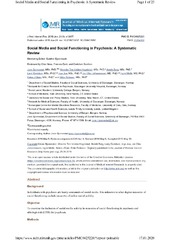| dc.contributor.author | Bjørnestad, Jone Ravndal | |
| dc.contributor.author | Hegelstad, Wenche | |
| dc.contributor.author | Berg, Henrik | |
| dc.contributor.author | Davidson, Larry | |
| dc.contributor.author | Joa, Inge | |
| dc.contributor.author | Johannessen, Jan Olav | |
| dc.contributor.author | Melle, Ingrid | |
| dc.contributor.author | Stain, Helen J. | |
| dc.contributor.author | Pallesen, Ståle | |
| dc.date.accessioned | 2020-04-24T14:07:05Z | |
| dc.date.available | 2020-04-24T14:07:05Z | |
| dc.date.issued | 2019-06-21 | |
| dc.Published | Bjørnestad JR, Hegelstad W, Berg H, Davidson L, Joa I, Johannessen JO, Melle I, Stain HJ, Pallesen S. Social media and social functioning in psychosis: A systematic review. Journal of Medical Internet Research. 2019;21(6):1-22 | eng |
| dc.identifier.issn | 1438-8871 | |
| dc.identifier.uri | https://hdl.handle.net/1956/21994 | |
| dc.description.abstract | Background: Individuals with psychosis are heavy consumers of social media. It is unknown to what degree measures of social functioning include measures of online social activity. Objective: To examine the inclusion of social media activity in measures of social functioning in psychosis and ultrahigh risk (UHR) for psychosis. Methods: Two independent authors conducted a search using the following electronic databases: Epistemonikos, Cochrane Database of Systematic Reviews, Database of Abstracts of Reviews of Effects, MEDLINE, Embase, and PsycINFO. The included articles were required to meet all of the following criteria: (1) an empirical study published in the English language in a peer-reviewed journal; (2) the study included a measure of objective or subjective offline (ie, non-Web-mediated contact) and/or online social functioning (ie, Web-mediated contact); (3) the social functioning measure had to be used in samples meeting criteria (ie, Diagnostic and Statistical Manual of Mental Disorders or International Classification of Diseases) for a psychotic disorder or UHR for psychosis; and (4) the study was published between January 2004 and February 2019. Facebook was launched as the first large-scale social media platform in 2004 and, therefore, it is highly improbable that studies conducted prior to 2004 would have included measures of social media activity. Results: The electronic search resulted in 11,844 distinct articles. Full-text evaluation was conducted on 719 articles, of which 597 articles met inclusion criteria. A total of 58 social functioning measures were identified. With some exceptions, reports on reliability and validity were scarce, and only one measure integrated social media social activity. Conclusions: The ecological validity of social functioning measures is challenged by the lack of assessment of social media activity, as it fails to reflect an important aspect of the current social reality of persons with psychosis. Measures should be revised to include social media activity and thus avoid the clinical consequences of inadequate assessment of social functioning. | en_US |
| dc.language.iso | eng | eng |
| dc.publisher | Journal of Medical Internet Research | eng |
| dc.rights | Attribution CC BY | eng |
| dc.rights.uri | https://creativecommons.org/licenses/by/4.0/ | eng |
| dc.title | Social media and social functioning in psychosis: A systematic review | eng |
| dc.type | Peer reviewed | |
| dc.type | Journal article | |
| dc.date.updated | 2020-01-17T20:45:40Z | |
| dc.description.version | publishedVersion | |
| dc.rights.holder | Copyright © Jone Bjornestad, Wenche Ten Velden Hegelstad, Henrik Berg, Larry Davidson, Inge Joa, Jan Olav Johannessen, Ingrid Melle, Helen J Stain, Ståle Pallesen. | eng |
| dc.identifier.doi | https://doi.org/10.2196/13957 | |
| dc.identifier.cristin | 1710012 | |
| dc.source.journal | Journal of Medical Internet Research | |

